AER 615 Aircraft Performance: Touch-and-Go Distance Calculation Report
VerifiedAdded on 2022/08/23
|11
|1039
|15
Report
AI Summary
This report presents a detailed analysis of the touch-and-go maneuver for a light aircraft, addressing the requirements of AER 615, an Aircraft Performance course. The objective is to determine the total distance needed for a touch-and-go maneuver, starting from a stalled-on landing from a 15.24-meter screen height, transitioning to a takeoff procedure to the same screen height. The analysis breaks down the maneuver into three key airborne segments: stalled-on landing, transition from landing to takeoff using the mean kinetic energy model, and takeoff. Calculations consider factors such as stall speed, approach velocity, radius of flare, mean thrust, lift and drag coefficients, ground effect, and the impact of tailwinds, adhering to FAR 25 specifications. The report provides step-by-step calculations for each segment, including the adjustment for tailwind effects. The final result provides the total ground distance needed for the maneuver, considering both the standard and the FAR 25 adjusted tailwind scenarios.
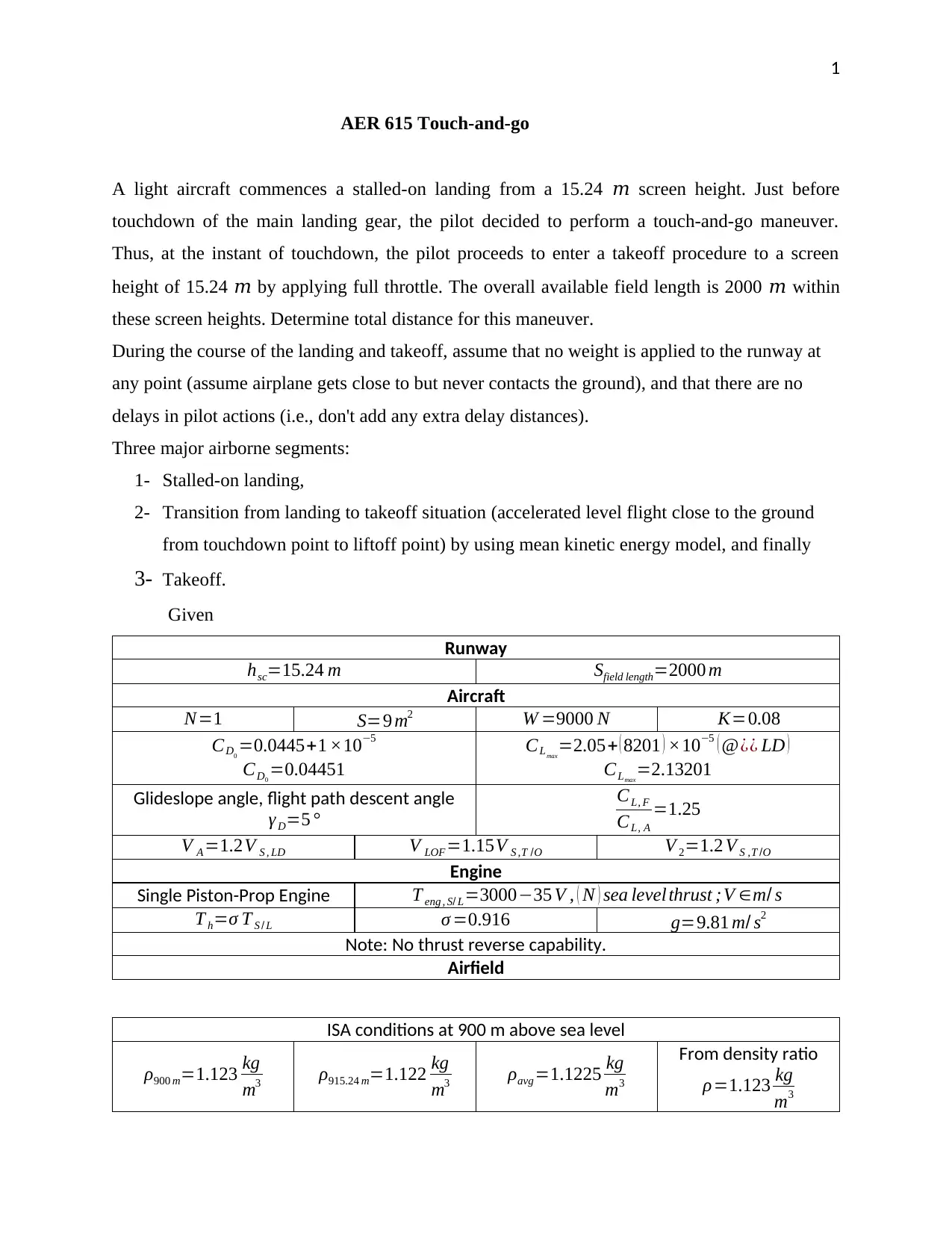
1
AER 615 Touch-and-go
A light aircraft commences a stalled-on landing from a 15.24 𝑚 screen height. Just before
touchdown of the main landing gear, the pilot decided to perform a touch-and-go maneuver.
Thus, at the instant of touchdown, the pilot proceeds to enter a takeoff procedure to a screen
height of 15.24 𝑚 by applying full throttle. The overall available field length is 2000 𝑚 within
these screen heights. Determine total distance for this maneuver.
During the course of the landing and takeoff, assume that no weight is applied to the runway at
any point (assume airplane gets close to but never contacts the ground), and that there are no
delays in pilot actions (i.e., don't add any extra delay distances).
Three major airborne segments:
1- Stalled-on landing,
2- Transition from landing to takeoff situation (accelerated level flight close to the ground
from touchdown point to liftoff point) by using mean kinetic energy model, and finally
3- Takeoff.
Given
Runway
hsc=15.24 m Sfield length=2000 m
Aircraft
N=1 S=9 m2 W =9000 N K=0.08
CD0
=0.0445+1 ×10−5
CD0
=0.04451
CLmax
=2.05+ ( 8201 ) ×10−5 ( @¿¿ LD )
CLmax
=2.13201
Glideslope angle, flight path descent angle
γ D=5 °
CL, F
CL, A
=1.25
V A =1.2V S , LD V LOF=1.15V S ,T /O V 2=1.2 V S ,T /O
Engine
Single Piston-Prop Engine T eng , S/ L=3000−35 V , ( N ) sea level thrust ;V ∈m/ s
T h=σ T S / L σ =0.916 g=9.81 m/ s2
Note: No thrust reverse capability.
Airfield
ISA conditions at 900 m above sea level
ρ900 m=1.123 kg
m3 ρ915.24 m=1.122 kg
m3 ρavg =1.1225 kg
m3
From density ratio
ρ=1.123 kg
m3
AER 615 Touch-and-go
A light aircraft commences a stalled-on landing from a 15.24 𝑚 screen height. Just before
touchdown of the main landing gear, the pilot decided to perform a touch-and-go maneuver.
Thus, at the instant of touchdown, the pilot proceeds to enter a takeoff procedure to a screen
height of 15.24 𝑚 by applying full throttle. The overall available field length is 2000 𝑚 within
these screen heights. Determine total distance for this maneuver.
During the course of the landing and takeoff, assume that no weight is applied to the runway at
any point (assume airplane gets close to but never contacts the ground), and that there are no
delays in pilot actions (i.e., don't add any extra delay distances).
Three major airborne segments:
1- Stalled-on landing,
2- Transition from landing to takeoff situation (accelerated level flight close to the ground
from touchdown point to liftoff point) by using mean kinetic energy model, and finally
3- Takeoff.
Given
Runway
hsc=15.24 m Sfield length=2000 m
Aircraft
N=1 S=9 m2 W =9000 N K=0.08
CD0
=0.0445+1 ×10−5
CD0
=0.04451
CLmax
=2.05+ ( 8201 ) ×10−5 ( @¿¿ LD )
CLmax
=2.13201
Glideslope angle, flight path descent angle
γ D=5 °
CL, F
CL, A
=1.25
V A =1.2V S , LD V LOF=1.15V S ,T /O V 2=1.2 V S ,T /O
Engine
Single Piston-Prop Engine T eng , S/ L=3000−35 V , ( N ) sea level thrust ;V ∈m/ s
T h=σ T S / L σ =0.916 g=9.81 m/ s2
Note: No thrust reverse capability.
Airfield
ISA conditions at 900 m above sea level
ρ900 m=1.123 kg
m3 ρ915.24 m=1.122 kg
m3 ρavg =1.1225 kg
m3
From density ratio
ρ=1.123 kg
m3
Paraphrase This Document
Need a fresh take? Get an instant paraphrase of this document with our AI Paraphraser
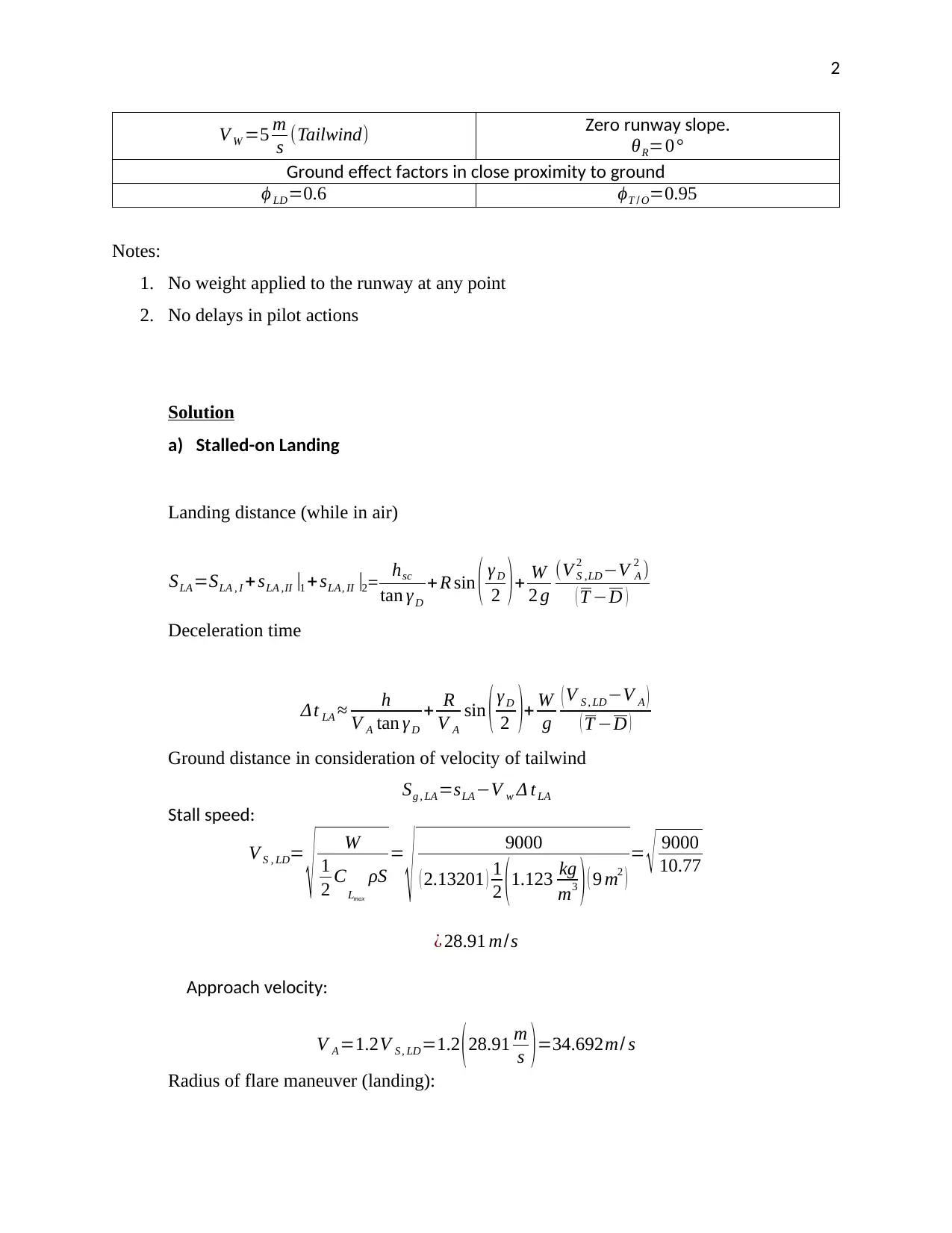
2
V W =5 m
s (Tailwind) Zero runway slope.
θR=0°
Ground effect factors in close proximity to ground
ϕ LD=0.6 ϕT / O=0.95
Notes:
1. No weight applied to the runway at any point
2. No delays in pilot actions
Solution
a) Stalled-on Landing
Landing distance (while in air)
SLA=SLA , I + sLA ,II |1 + sLA, II |2= hsc
tan γ D
+ R sin ( γ D
2 ) + W
2 g
(V S ,LD
2 −V A
2 )
( T −D )
Deceleration time
Δ t LA ≈ h
V A tan γ D
+ R
V A
sin ( γ D
2 )+ W
g
( V S , LD−V A )
( T −D )
Ground distance in consideration of velocity of tailwind
Sg , LA=sLA−V w Δ t LA
Stall speed:
V S , LD=
√ W
1
2 CLmax
ρS
=
√ 9000
( 2.13201 ) 1
2 (1.123 kg
m3 ) ( 9 m2 )
= √ 9000
10.77
¿ 28.91 m/s
Approach velocity:
V A =1.2V S , LD=1.2 (28.91 m
s )=34.692m/ s
Radius of flare maneuver (landing):
V W =5 m
s (Tailwind) Zero runway slope.
θR=0°
Ground effect factors in close proximity to ground
ϕ LD=0.6 ϕT / O=0.95
Notes:
1. No weight applied to the runway at any point
2. No delays in pilot actions
Solution
a) Stalled-on Landing
Landing distance (while in air)
SLA=SLA , I + sLA ,II |1 + sLA, II |2= hsc
tan γ D
+ R sin ( γ D
2 ) + W
2 g
(V S ,LD
2 −V A
2 )
( T −D )
Deceleration time
Δ t LA ≈ h
V A tan γ D
+ R
V A
sin ( γ D
2 )+ W
g
( V S , LD−V A )
( T −D )
Ground distance in consideration of velocity of tailwind
Sg , LA=sLA−V w Δ t LA
Stall speed:
V S , LD=
√ W
1
2 CLmax
ρS
=
√ 9000
( 2.13201 ) 1
2 (1.123 kg
m3 ) ( 9 m2 )
= √ 9000
10.77
¿ 28.91 m/s
Approach velocity:
V A =1.2V S , LD=1.2 (28.91 m
s )=34.692m/ s
Radius of flare maneuver (landing):
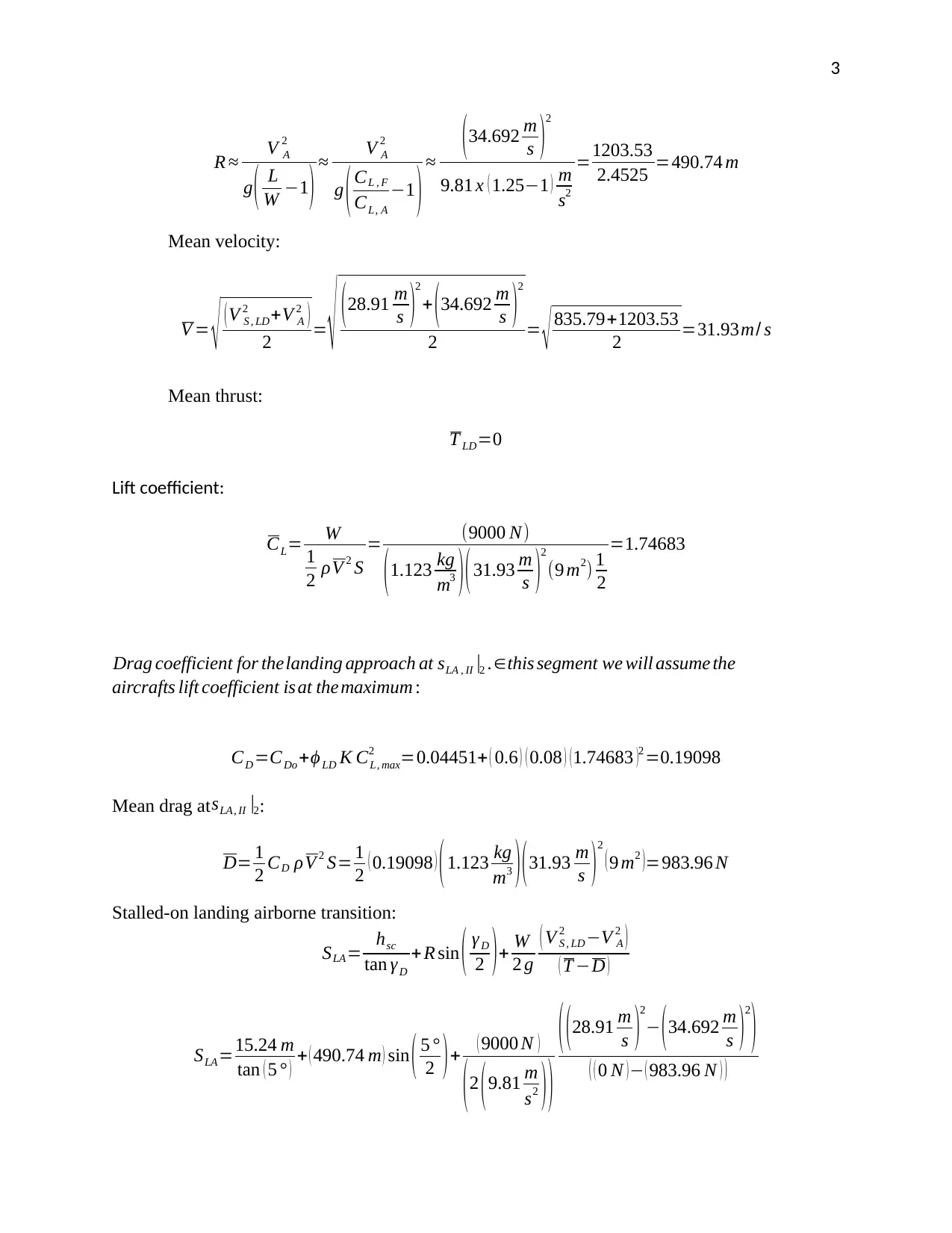
3
R ≈ V A
2
g ( L
W −1 ) ≈ V A
2
g ( CL , F
CL, A
−1 ) ≈ (34.692 m
s )2
9.81 x ( 1.25−1 ) m
s2
=1203.53
2.4525 =490.74 m
Mean velocity:
V = √ (V S , LD
2 +V A
2 )
2 = √ (28.91 m
s )2
+ (34.692 m
s )2
2 = √ 835.79+1203.53
2 =31.93m/ s
Mean thrust:
T LD=0
Lift coefficient:
CL= W
1
2 ρV 2 S
= (9000 N)
(1.123 kg
m3 ) (31.93 m
s )2
(9 m2) 1
2
=1.74683
Drag coefficient for thelanding approach at sLA , II |2 .∈this segment we will assume the
aircrafts lift coefficient isat themaximum :
CD =CDo +ϕ LD K CL, max
2 =0.04451+ ( 0.6 ) ( 0.08 ) ( 1.74683 )2 =0.19098
Mean drag atsLA, II |2:
D= 1
2 CD ρV 2 S= 1
2 ( 0.19098 ) (1.123 kg
m3 ) (31.93 m
s )2
( 9 m2 )=983.96 N
Stalled-on landing airborne transition:
SLA= hsc
tan γ D
+ R sin ( γ D
2 )+ W
2 g
( V S , LD
2 −V A
2 )
( T −D )
SLA=15.24 m
tan ( 5 ° ) + ( 490.74 m ) sin ( 5 °
2 ) + ( 9000 N )
( 2 ( 9.81 m
s2 ) )
( ( 28.91 m
s )
2
− ( 34.692 m
s )
2
)
( ( 0 N ) − ( 983.96 N ) )
R ≈ V A
2
g ( L
W −1 ) ≈ V A
2
g ( CL , F
CL, A
−1 ) ≈ (34.692 m
s )2
9.81 x ( 1.25−1 ) m
s2
=1203.53
2.4525 =490.74 m
Mean velocity:
V = √ (V S , LD
2 +V A
2 )
2 = √ (28.91 m
s )2
+ (34.692 m
s )2
2 = √ 835.79+1203.53
2 =31.93m/ s
Mean thrust:
T LD=0
Lift coefficient:
CL= W
1
2 ρV 2 S
= (9000 N)
(1.123 kg
m3 ) (31.93 m
s )2
(9 m2) 1
2
=1.74683
Drag coefficient for thelanding approach at sLA , II |2 .∈this segment we will assume the
aircrafts lift coefficient isat themaximum :
CD =CDo +ϕ LD K CL, max
2 =0.04451+ ( 0.6 ) ( 0.08 ) ( 1.74683 )2 =0.19098
Mean drag atsLA, II |2:
D= 1
2 CD ρV 2 S= 1
2 ( 0.19098 ) (1.123 kg
m3 ) (31.93 m
s )2
( 9 m2 )=983.96 N
Stalled-on landing airborne transition:
SLA= hsc
tan γ D
+ R sin ( γ D
2 )+ W
2 g
( V S , LD
2 −V A
2 )
( T −D )
SLA=15.24 m
tan ( 5 ° ) + ( 490.74 m ) sin ( 5 °
2 ) + ( 9000 N )
( 2 ( 9.81 m
s2 ) )
( ( 28.91 m
s )
2
− ( 34.692 m
s )
2
)
( ( 0 N ) − ( 983.96 N ) )
⊘ This is a preview!⊘
Do you want full access?
Subscribe today to unlock all pages.

Trusted by 1+ million students worldwide
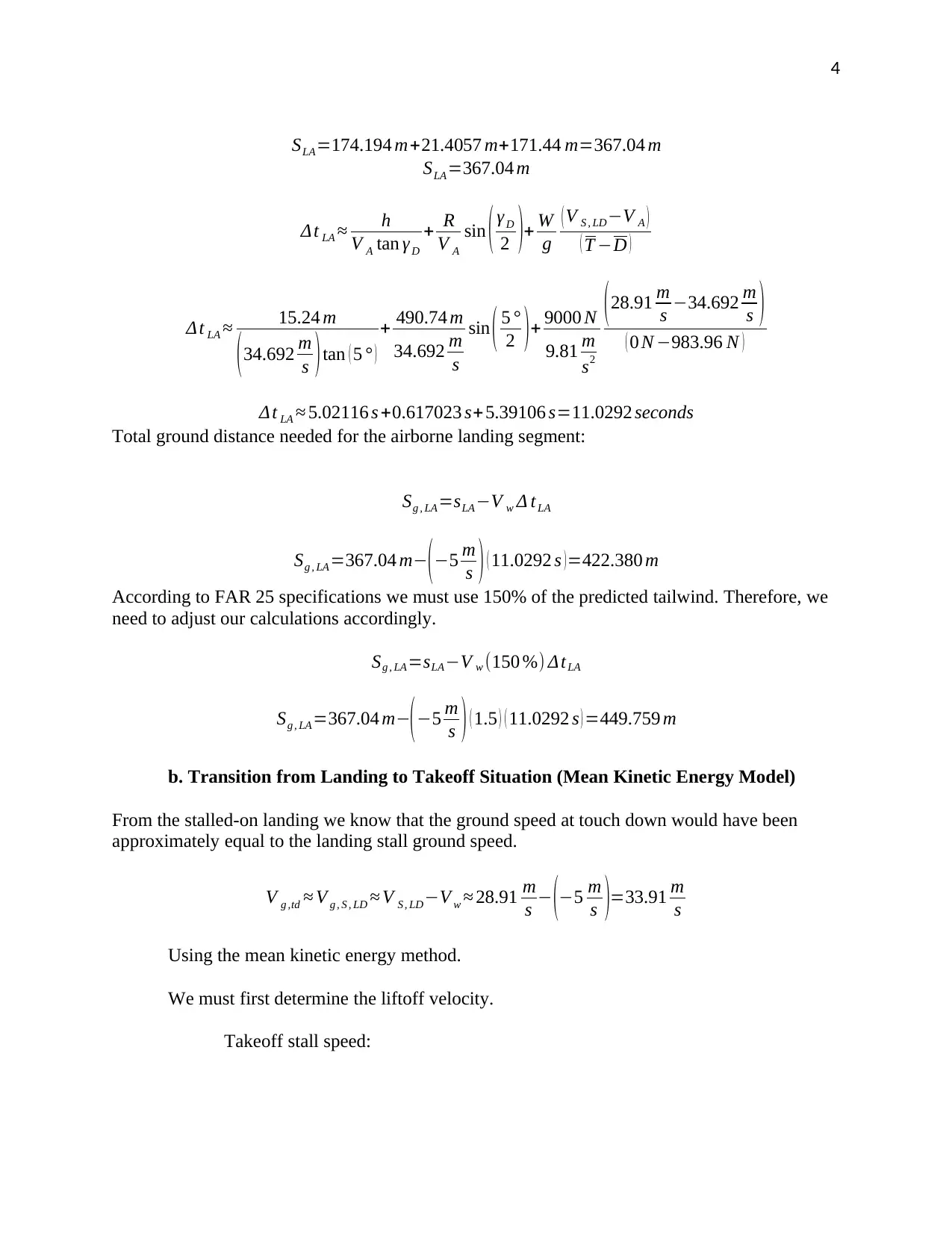
4
SLA=174.194 m+21.4057 m+171.44 m=367.04 m
SLA=367.04 m
Δ t LA ≈ h
V A tan γ D
+ R
V A
sin ( γ D
2 )+ W
g
( V S , LD−V A )
( T −D )
Δ t LA ≈ 15.24 m
(34.692 m
s )tan ( 5 ° )
+ 490.74 m
34.692 m
s
sin ( 5 °
2 )+ 9000 N
9.81 m
s2
(28.91 m
s −34.692 m
s )
( 0 N −983.96 N )
Δ t LA ≈ 5.02116 s +0.617023 s+5.39106 s=11.0292 seconds
Total ground distance needed for the airborne landing segment:
Sg , LA=sLA−V w Δ t LA
Sg , LA=367.04 m−(−5 m
s ) ( 11.0292 s )=422.380 m
According to FAR 25 specifications we must use 150% of the predicted tailwind. Therefore, we
need to adjust our calculations accordingly.
Sg , LA=sLA−V w (150 %) Δ tLA
Sg , LA=367.04 m−(−5 m
s ) ( 1.5 ) ( 11.0292 s ) =449.759 m
b. Transition from Landing to Takeoff Situation (Mean Kinetic Energy Model)
From the stalled-on landing we know that the ground speed at touch down would have been
approximately equal to the landing stall ground speed.
V g ,td ≈ V g , S , LD ≈ V S , LD−V w ≈ 28.91 m
s − (−5 m
s )=33.91 m
s
Using the mean kinetic energy method.
We must first determine the liftoff velocity.
Takeoff stall speed:
SLA=174.194 m+21.4057 m+171.44 m=367.04 m
SLA=367.04 m
Δ t LA ≈ h
V A tan γ D
+ R
V A
sin ( γ D
2 )+ W
g
( V S , LD−V A )
( T −D )
Δ t LA ≈ 15.24 m
(34.692 m
s )tan ( 5 ° )
+ 490.74 m
34.692 m
s
sin ( 5 °
2 )+ 9000 N
9.81 m
s2
(28.91 m
s −34.692 m
s )
( 0 N −983.96 N )
Δ t LA ≈ 5.02116 s +0.617023 s+5.39106 s=11.0292 seconds
Total ground distance needed for the airborne landing segment:
Sg , LA=sLA−V w Δ t LA
Sg , LA=367.04 m−(−5 m
s ) ( 11.0292 s )=422.380 m
According to FAR 25 specifications we must use 150% of the predicted tailwind. Therefore, we
need to adjust our calculations accordingly.
Sg , LA=sLA−V w (150 %) Δ tLA
Sg , LA=367.04 m−(−5 m
s ) ( 1.5 ) ( 11.0292 s ) =449.759 m
b. Transition from Landing to Takeoff Situation (Mean Kinetic Energy Model)
From the stalled-on landing we know that the ground speed at touch down would have been
approximately equal to the landing stall ground speed.
V g ,td ≈ V g , S , LD ≈ V S , LD−V w ≈ 28.91 m
s − (−5 m
s )=33.91 m
s
Using the mean kinetic energy method.
We must first determine the liftoff velocity.
Takeoff stall speed:
Paraphrase This Document
Need a fresh take? Get an instant paraphrase of this document with our AI Paraphraser
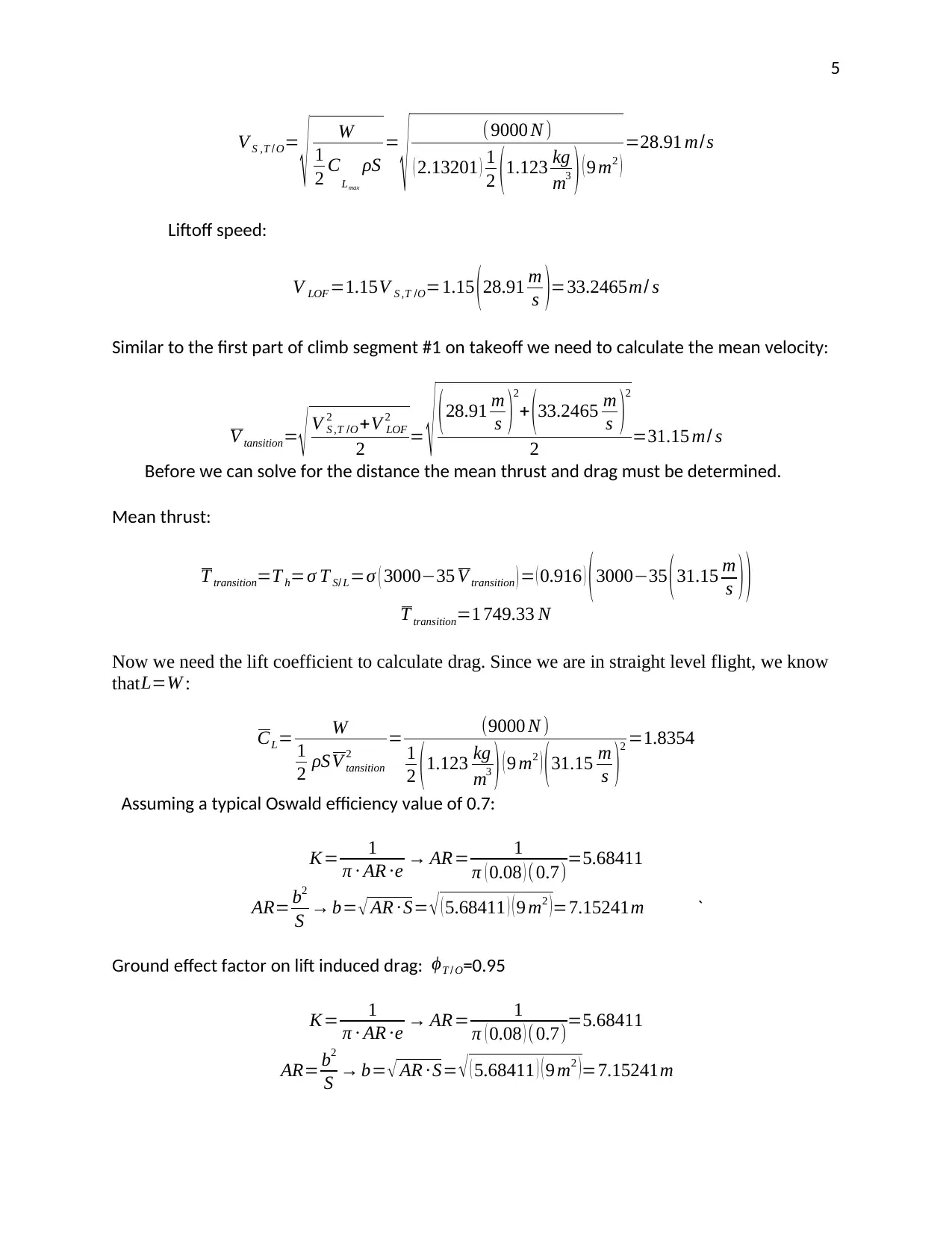
5
V S ,T / O=
√ W
1
2 CLmax
ρS
=
√ ( 9000 N )
( 2.13201 ) 1
2 ( 1.123 kg
m3 ) ( 9 m2 )
=28.91 m/s
Liftoff speed:
V LOF =1.15V S ,T /O=1.15 (28.91 m
s )=33.2465m/ s
Similar to the first part of climb segment #1 on takeoff we need to calculate the mean velocity:
V tansition= √ V S ,T /O
2 +V LOF
2
2 = √ ( 28.91 m
s )
2
+ ( 33.2465 m
s )
2
2 =31.15 m/ s
Before we can solve for the distance the mean thrust and drag must be determined.
Mean thrust:
T transition=T h=σ T S/ L=σ ( 3000−35 V transition ) = ( 0.916 ) (3000−35 (31.15 m
s ) )
T transition=1 749.33 N
Now we need the lift coefficient to calculate drag. Since we are in straight level flight, we know
that L=W :
CL= W
1
2 ρSV tansition
2
= (9000 N )
1
2 (1.123 kg
m3 ) ( 9 m2 ) (31.15 m
s )2 =1.8354
Assuming a typical Oswald efficiency value of 0.7:
K= 1
π ∙ AR ∙e → AR= 1
π ( 0.08 ) ( 0.7)=5.68411
AR= b2
S → b= √ AR ∙ S= √ ( 5.68411 ) ( 9 m2 )=7.15241m `
Ground effect factor on lift induced drag: ϕT / O=0.95
K= 1
π ∙ AR ∙e → AR= 1
π ( 0.08 ) ( 0.7)=5.68411
AR= b2
S → b= √ AR ∙ S= √ ( 5.68411 ) ( 9 m2 )=7.15241m
V S ,T / O=
√ W
1
2 CLmax
ρS
=
√ ( 9000 N )
( 2.13201 ) 1
2 ( 1.123 kg
m3 ) ( 9 m2 )
=28.91 m/s
Liftoff speed:
V LOF =1.15V S ,T /O=1.15 (28.91 m
s )=33.2465m/ s
Similar to the first part of climb segment #1 on takeoff we need to calculate the mean velocity:
V tansition= √ V S ,T /O
2 +V LOF
2
2 = √ ( 28.91 m
s )
2
+ ( 33.2465 m
s )
2
2 =31.15 m/ s
Before we can solve for the distance the mean thrust and drag must be determined.
Mean thrust:
T transition=T h=σ T S/ L=σ ( 3000−35 V transition ) = ( 0.916 ) (3000−35 (31.15 m
s ) )
T transition=1 749.33 N
Now we need the lift coefficient to calculate drag. Since we are in straight level flight, we know
that L=W :
CL= W
1
2 ρSV tansition
2
= (9000 N )
1
2 (1.123 kg
m3 ) ( 9 m2 ) (31.15 m
s )2 =1.8354
Assuming a typical Oswald efficiency value of 0.7:
K= 1
π ∙ AR ∙e → AR= 1
π ( 0.08 ) ( 0.7)=5.68411
AR= b2
S → b= √ AR ∙ S= √ ( 5.68411 ) ( 9 m2 )=7.15241m `
Ground effect factor on lift induced drag: ϕT / O=0.95
K= 1
π ∙ AR ∙e → AR= 1
π ( 0.08 ) ( 0.7)=5.68411
AR= b2
S → b= √ AR ∙ S= √ ( 5.68411 ) ( 9 m2 )=7.15241m
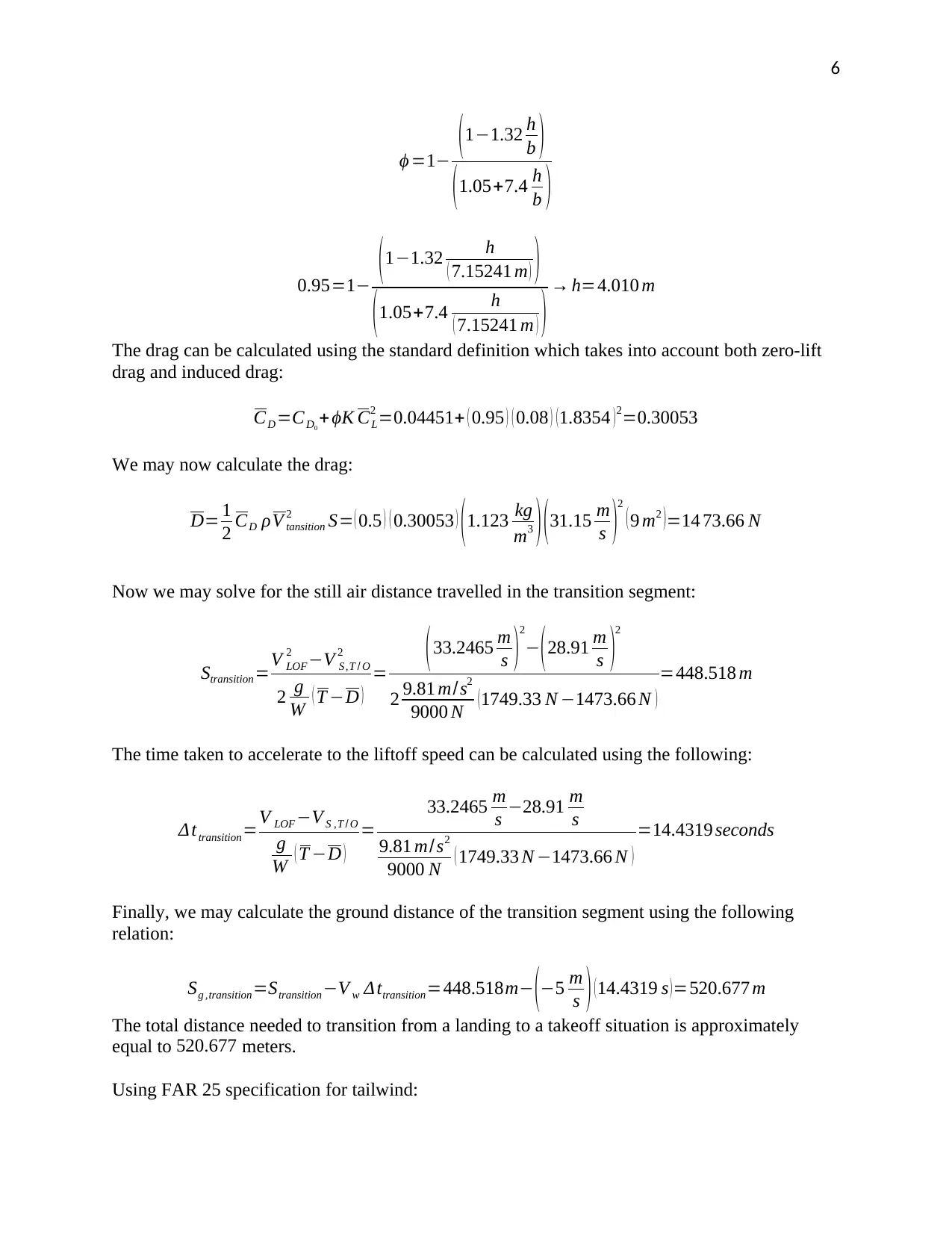
6
ϕ =1− (1−1.32 h
b )
(1.05+7.4 h
b )
0.95=1− ( 1−1.32 h
( 7.15241 m ) )
( 1.05+7.4 h
( 7.15241 m ) ) → h=4.010 m
The drag can be calculated using the standard definition which takes into account both zero-lift
drag and induced drag:
CD =CD0
+ ϕK CL
2 =0.04451+ ( 0.95 ) ( 0.08 ) ( 1.8354 ) 2=0.30053
We may now calculate the drag:
D= 1
2 CD ρV tansition
2 S= ( 0.5 ) ( 0.30053 ) ( 1.123 kg
m3 ) ( 31.15 m
s )
2
( 9 m2 ) =14 73.66 N
Now we may solve for the still air distance travelled in the transition segment:
Stransition=V LOF
2 −V S ,T / O
2
2 g
W ( T −D )
= (33.2465 m
s )2
− (28.91 m
s )2
2 9.81 m/s2
9000 N (1749.33 N −1473.66 N )
=448.518 m
The time taken to accelerate to the liftoff speed can be calculated using the following:
Δ ttransition=V LOF −V S ,T / O
g
W ( T −D )
=
33.2465 m
s −28.91 m
s
9.81 m/s2
9000 N ( 1749.33 N −1473.66 N )
=14.4319 seconds
Finally, we may calculate the ground distance of the transition segment using the following
relation:
Sg ,transition=Stransition−V w Δ ttransition=448.518m− (−5 m
s ) (14.4319 s )=520.677 m
The total distance needed to transition from a landing to a takeoff situation is approximately
equal to 520.677 meters.
Using FAR 25 specification for tailwind:
ϕ =1− (1−1.32 h
b )
(1.05+7.4 h
b )
0.95=1− ( 1−1.32 h
( 7.15241 m ) )
( 1.05+7.4 h
( 7.15241 m ) ) → h=4.010 m
The drag can be calculated using the standard definition which takes into account both zero-lift
drag and induced drag:
CD =CD0
+ ϕK CL
2 =0.04451+ ( 0.95 ) ( 0.08 ) ( 1.8354 ) 2=0.30053
We may now calculate the drag:
D= 1
2 CD ρV tansition
2 S= ( 0.5 ) ( 0.30053 ) ( 1.123 kg
m3 ) ( 31.15 m
s )
2
( 9 m2 ) =14 73.66 N
Now we may solve for the still air distance travelled in the transition segment:
Stransition=V LOF
2 −V S ,T / O
2
2 g
W ( T −D )
= (33.2465 m
s )2
− (28.91 m
s )2
2 9.81 m/s2
9000 N (1749.33 N −1473.66 N )
=448.518 m
The time taken to accelerate to the liftoff speed can be calculated using the following:
Δ ttransition=V LOF −V S ,T / O
g
W ( T −D )
=
33.2465 m
s −28.91 m
s
9.81 m/s2
9000 N ( 1749.33 N −1473.66 N )
=14.4319 seconds
Finally, we may calculate the ground distance of the transition segment using the following
relation:
Sg ,transition=Stransition−V w Δ ttransition=448.518m− (−5 m
s ) (14.4319 s )=520.677 m
The total distance needed to transition from a landing to a takeoff situation is approximately
equal to 520.677 meters.
Using FAR 25 specification for tailwind:
⊘ This is a preview!⊘
Do you want full access?
Subscribe today to unlock all pages.

Trusted by 1+ million students worldwide
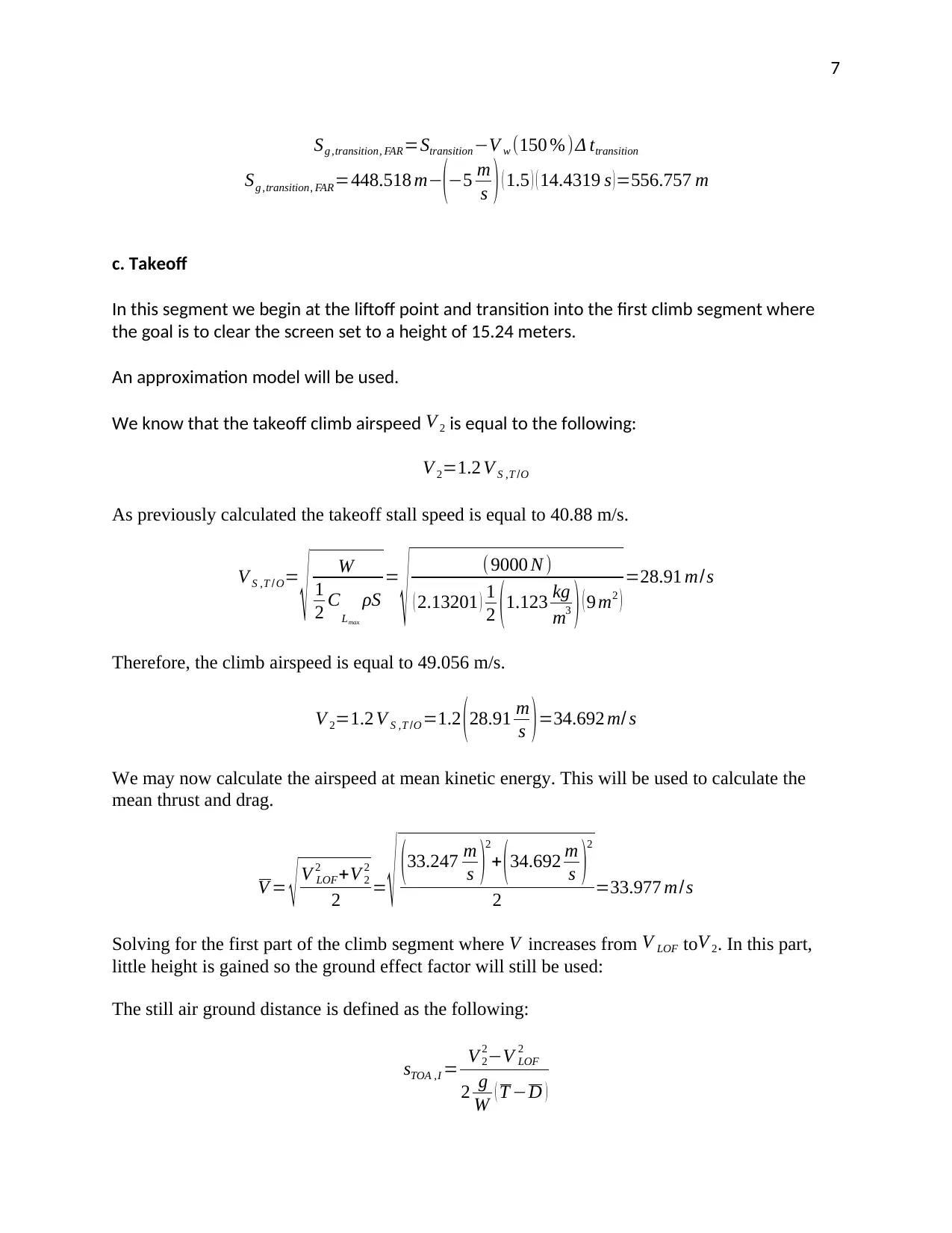
7
Sg ,transition, FAR=Stransition−V w (150 % )Δ ttransition
Sg ,transition, FAR=448.518 m−(−5 m
s ) ( 1.5 ) ( 14.4319 s )=556.757 m
c. Takeoff
In this segment we begin at the liftoff point and transition into the first climb segment where
the goal is to clear the screen set to a height of 15.24 meters.
An approximation model will be used.
We know that the takeoff climb airspeed V 2 is equal to the following:
V 2=1.2 V S ,T /O
As previously calculated the takeoff stall speed is equal to 40.88 m/s.
V S ,T / O=
√ W
1
2 CLmax
ρS
=
√ ( 9000 N )
( 2.13201 ) 1
2 ( 1.123 kg
m3 ) ( 9 m2 )
=28.91 m/s
Therefore, the climb airspeed is equal to 49.056 m/s.
V 2=1.2 V S ,T /O =1.2 (28.91 m
s )=34.692 m/ s
We may now calculate the airspeed at mean kinetic energy. This will be used to calculate the
mean thrust and drag.
V = √ V LOF
2 +V 2
2
2 = √ ( 33.247 m
s )
2
+ ( 34.692 m
s )
2
2 =33.977 m/s
Solving for the first part of the climb segment where V increases from V LOF toV 2. In this part,
little height is gained so the ground effect factor will still be used:
The still air ground distance is defined as the following:
sTOA ,I = V 2
2−V LOF
2
2 g
W ( T −D )
Sg ,transition, FAR=Stransition−V w (150 % )Δ ttransition
Sg ,transition, FAR=448.518 m−(−5 m
s ) ( 1.5 ) ( 14.4319 s )=556.757 m
c. Takeoff
In this segment we begin at the liftoff point and transition into the first climb segment where
the goal is to clear the screen set to a height of 15.24 meters.
An approximation model will be used.
We know that the takeoff climb airspeed V 2 is equal to the following:
V 2=1.2 V S ,T /O
As previously calculated the takeoff stall speed is equal to 40.88 m/s.
V S ,T / O=
√ W
1
2 CLmax
ρS
=
√ ( 9000 N )
( 2.13201 ) 1
2 ( 1.123 kg
m3 ) ( 9 m2 )
=28.91 m/s
Therefore, the climb airspeed is equal to 49.056 m/s.
V 2=1.2 V S ,T /O =1.2 (28.91 m
s )=34.692 m/ s
We may now calculate the airspeed at mean kinetic energy. This will be used to calculate the
mean thrust and drag.
V = √ V LOF
2 +V 2
2
2 = √ ( 33.247 m
s )
2
+ ( 34.692 m
s )
2
2 =33.977 m/s
Solving for the first part of the climb segment where V increases from V LOF toV 2. In this part,
little height is gained so the ground effect factor will still be used:
The still air ground distance is defined as the following:
sTOA ,I = V 2
2−V LOF
2
2 g
W ( T −D )
Paraphrase This Document
Need a fresh take? Get an instant paraphrase of this document with our AI Paraphraser
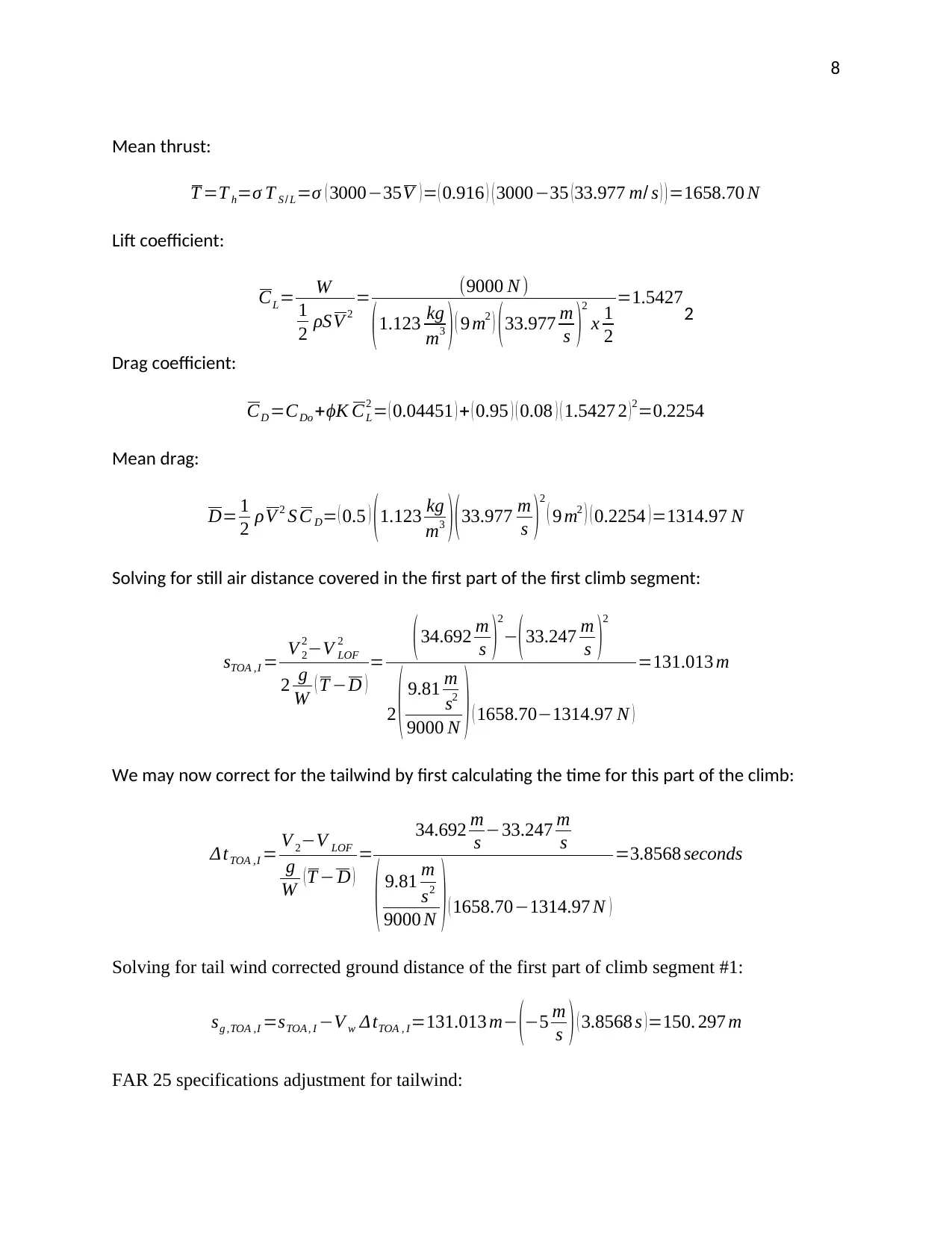
8
Mean thrust:
T =T h=σ T S / L=σ ( 3000−35V ) = ( 0.916 ) ( 3000−35 ( 33.977 m/ s ) ) =1658.70 N
Lift coefficient:
CL= W
1
2 ρSV 2
= (9000 N )
(1.123 kg
m3 ) ( 9 m2 ) (33.977 m
s )2
x 1
2
=1.54272
Drag coefficient:
CD =CDo +ϕK CL
2 = ( 0.04451 ) + ( 0.95 ) ( 0.08 ) ( 1.5427 2 ) 2=0.2254
Mean drag:
D= 1
2 ρV 2 S C D= ( 0.5 ) (1.123 kg
m3 ) (33.977 m
s )2
( 9 m2 ) ( 0.2254 )=1314.97 N
Solving for still air distance covered in the first part of the first climb segment:
sTOA ,I = V 2
2−V LOF
2
2 g
W ( T −D )
= ( 34.692 m
s )
2
−( 33.247 m
s )
2
2 ( 9.81 m
s2
9000 N ) ( 1658.70−1314.97 N )
=131.013 m
We may now correct for the tailwind by first calculating the time for this part of the climb:
Δ tTOA ,I = V 2−V LOF
g
W (T − D )
=
34.692 m
s −33.247 m
s
( 9.81 m
s2
9000 N ) ( 1658.70−1314.97 N )
=3.8568 seconds
Solving for tail wind corrected ground distance of the first part of climb segment #1:
sg ,TOA ,I =sTOA , I −V w Δ tTOA , I=131.013 m− (−5 m
s ) ( 3.8568 s )=150. 297 m
FAR 25 specifications adjustment for tailwind:
Mean thrust:
T =T h=σ T S / L=σ ( 3000−35V ) = ( 0.916 ) ( 3000−35 ( 33.977 m/ s ) ) =1658.70 N
Lift coefficient:
CL= W
1
2 ρSV 2
= (9000 N )
(1.123 kg
m3 ) ( 9 m2 ) (33.977 m
s )2
x 1
2
=1.54272
Drag coefficient:
CD =CDo +ϕK CL
2 = ( 0.04451 ) + ( 0.95 ) ( 0.08 ) ( 1.5427 2 ) 2=0.2254
Mean drag:
D= 1
2 ρV 2 S C D= ( 0.5 ) (1.123 kg
m3 ) (33.977 m
s )2
( 9 m2 ) ( 0.2254 )=1314.97 N
Solving for still air distance covered in the first part of the first climb segment:
sTOA ,I = V 2
2−V LOF
2
2 g
W ( T −D )
= ( 34.692 m
s )
2
−( 33.247 m
s )
2
2 ( 9.81 m
s2
9000 N ) ( 1658.70−1314.97 N )
=131.013 m
We may now correct for the tailwind by first calculating the time for this part of the climb:
Δ tTOA ,I = V 2−V LOF
g
W (T − D )
=
34.692 m
s −33.247 m
s
( 9.81 m
s2
9000 N ) ( 1658.70−1314.97 N )
=3.8568 seconds
Solving for tail wind corrected ground distance of the first part of climb segment #1:
sg ,TOA ,I =sTOA , I −V w Δ tTOA , I=131.013 m− (−5 m
s ) ( 3.8568 s )=150. 297 m
FAR 25 specifications adjustment for tailwind:
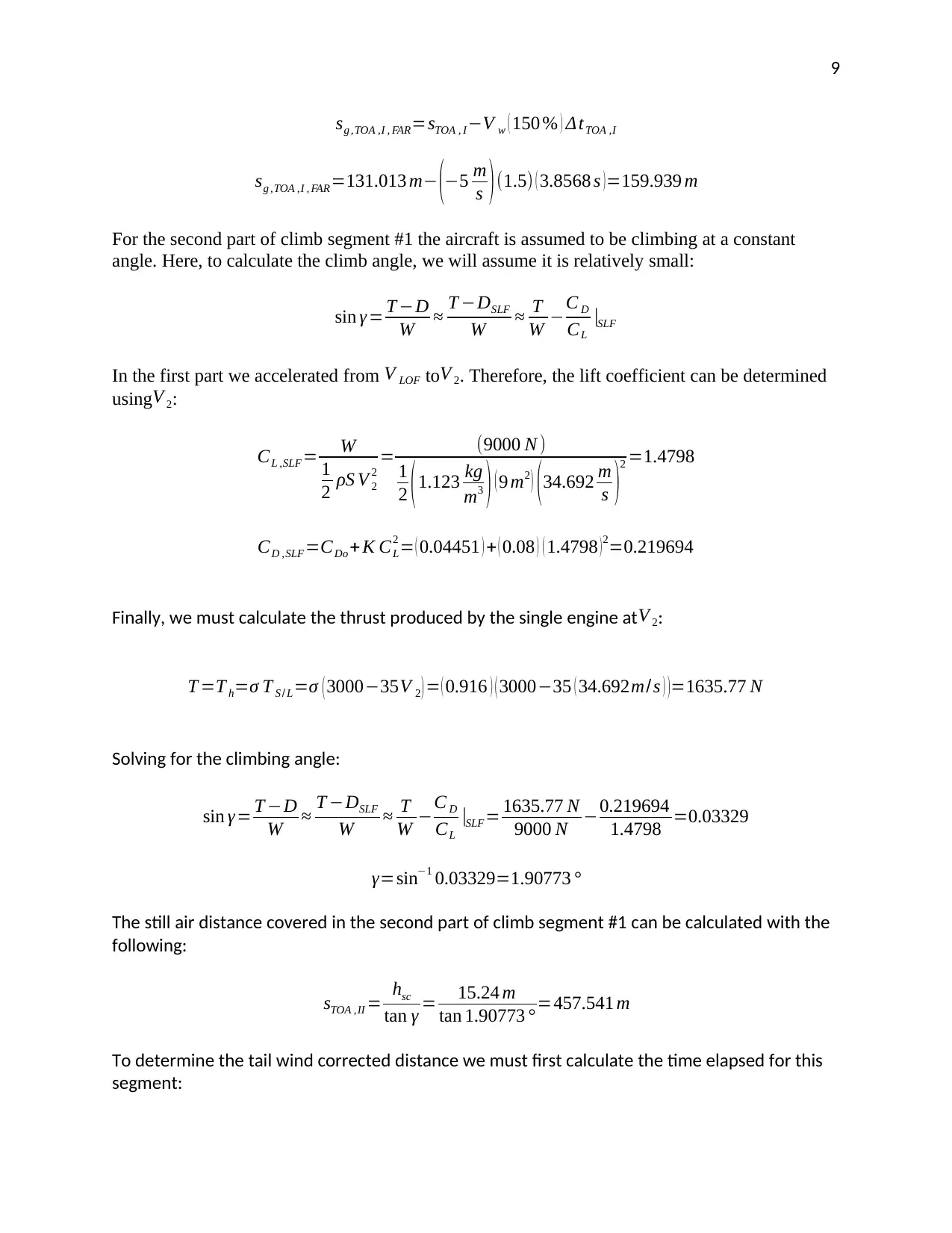
9
sg ,TOA ,I , FAR=sTOA , I−V w ( 150 % ) ΔtTOA ,I
sg ,TOA ,I , FAR=131.013 m− (−5 m
s ) (1.5) ( 3.8568 s ) =159.939 m
For the second part of climb segment #1 the aircraft is assumed to be climbing at a constant
angle. Here, to calculate the climb angle, we will assume it is relatively small:
sin γ= T −D
W ≈ T −DSLF
W ≈ T
W −C D
CL
|SLF
In the first part we accelerated from V LOF toV 2. Therefore, the lift coefficient can be determined
usingV 2:
CL ,SLF = W
1
2 ρS V 2
2
= (9000 N )
1
2 (1.123 kg
m3 ) ( 9 m2 ) (34.692 m
s )2 =1.4798
CD ,SLF=CDo + K CL
2 = ( 0.04451 ) + ( 0.08 ) ( 1.4798 )2=0.219694
Finally, we must calculate the thrust produced by the single engine atV 2:
T =T h=σ T S / L=σ ( 3000−35V 2 ) = ( 0.916 ) ( 3000−35 ( 34.692m/s ) )=1635.77 N
Solving for the climbing angle:
sin γ= T −D
W ≈ T −DSLF
W ≈ T
W −C D
CL
|SLF= 1635.77 N
9000 N −0.219694
1.4798 =0.03329
γ=sin−1 0.03329=1.90773 °
The still air distance covered in the second part of climb segment #1 can be calculated with the
following:
sTOA ,II = hsc
tan γ = 15.24 m
tan 1.90773 °=457.541 m
To determine the tail wind corrected distance we must first calculate the time elapsed for this
segment:
sg ,TOA ,I , FAR=sTOA , I−V w ( 150 % ) ΔtTOA ,I
sg ,TOA ,I , FAR=131.013 m− (−5 m
s ) (1.5) ( 3.8568 s ) =159.939 m
For the second part of climb segment #1 the aircraft is assumed to be climbing at a constant
angle. Here, to calculate the climb angle, we will assume it is relatively small:
sin γ= T −D
W ≈ T −DSLF
W ≈ T
W −C D
CL
|SLF
In the first part we accelerated from V LOF toV 2. Therefore, the lift coefficient can be determined
usingV 2:
CL ,SLF = W
1
2 ρS V 2
2
= (9000 N )
1
2 (1.123 kg
m3 ) ( 9 m2 ) (34.692 m
s )2 =1.4798
CD ,SLF=CDo + K CL
2 = ( 0.04451 ) + ( 0.08 ) ( 1.4798 )2=0.219694
Finally, we must calculate the thrust produced by the single engine atV 2:
T =T h=σ T S / L=σ ( 3000−35V 2 ) = ( 0.916 ) ( 3000−35 ( 34.692m/s ) )=1635.77 N
Solving for the climbing angle:
sin γ= T −D
W ≈ T −DSLF
W ≈ T
W −C D
CL
|SLF= 1635.77 N
9000 N −0.219694
1.4798 =0.03329
γ=sin−1 0.03329=1.90773 °
The still air distance covered in the second part of climb segment #1 can be calculated with the
following:
sTOA ,II = hsc
tan γ = 15.24 m
tan 1.90773 °=457.541 m
To determine the tail wind corrected distance we must first calculate the time elapsed for this
segment:
⊘ This is a preview!⊘
Do you want full access?
Subscribe today to unlock all pages.

Trusted by 1+ million students worldwide
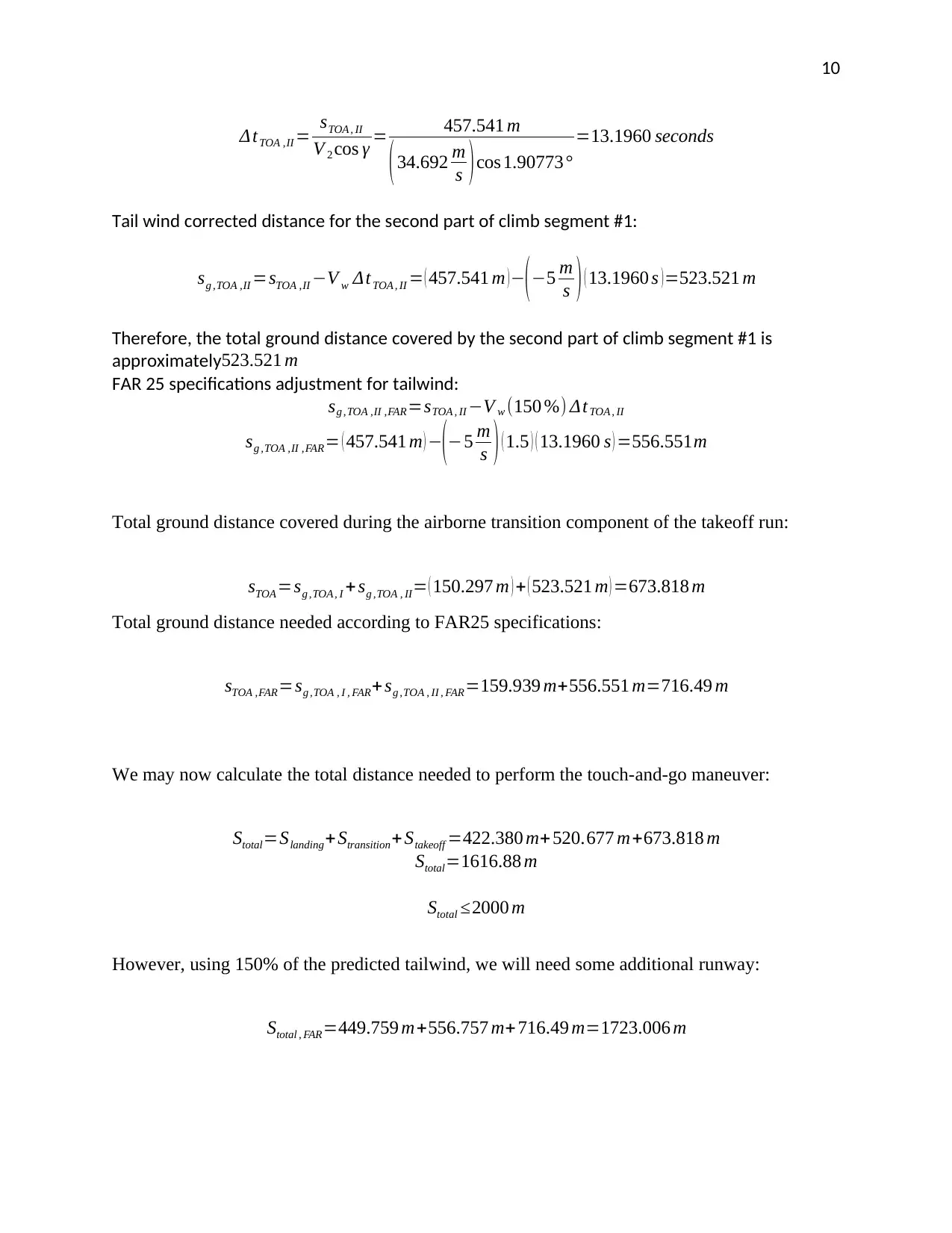
10
Δ tTOA ,II = sTOA , II
V 2 cos γ = 457.541 m
(34.692 m
s )cos 1.90773°
=13.1960 seconds
Tail wind corrected distance for the second part of climb segment #1:
sg ,TOA ,II =sTOA ,II −V w Δt TOA , II = ( 457.541 m )−(−5 m
s ) ( 13.1960 s )=523.521 m
Therefore, the total ground distance covered by the second part of climb segment #1 is
approximately 523.521 m
FAR 25 specifications adjustment for tailwind:
sg ,TOA ,II ,FAR=sTOA , II −V w (150 %) ΔtTOA , II
sg ,TOA ,II ,FAR= ( 457.541 m ) −(−5 m
s ) ( 1.5 ) ( 13.1960 s ) =556.551m
Total ground distance covered during the airborne transition component of the takeoff run:
sTOA =sg ,TOA , I + sg ,TOA , II= ( 150.297 m ) + ( 523.521 m ) =673.818 m
Total ground distance needed according to FAR25 specifications:
sTOA ,FAR=sg ,TOA , I , FAR+ sg ,TOA , II , FAR=159.939 m+556.551 m=716.49 m
We may now calculate the total distance needed to perform the touch-and-go maneuver:
Stotal=Slanding+Stransition+ Stakeoff =422.380 m+ 520.677 m+673.818 m
Stotal=1616.88 m
Stotal ≤2000 m
However, using 150% of the predicted tailwind, we will need some additional runway:
Stotal , FAR=449.759 m+556.757 m+716.49 m=1723.006 m
Δ tTOA ,II = sTOA , II
V 2 cos γ = 457.541 m
(34.692 m
s )cos 1.90773°
=13.1960 seconds
Tail wind corrected distance for the second part of climb segment #1:
sg ,TOA ,II =sTOA ,II −V w Δt TOA , II = ( 457.541 m )−(−5 m
s ) ( 13.1960 s )=523.521 m
Therefore, the total ground distance covered by the second part of climb segment #1 is
approximately 523.521 m
FAR 25 specifications adjustment for tailwind:
sg ,TOA ,II ,FAR=sTOA , II −V w (150 %) ΔtTOA , II
sg ,TOA ,II ,FAR= ( 457.541 m ) −(−5 m
s ) ( 1.5 ) ( 13.1960 s ) =556.551m
Total ground distance covered during the airborne transition component of the takeoff run:
sTOA =sg ,TOA , I + sg ,TOA , II= ( 150.297 m ) + ( 523.521 m ) =673.818 m
Total ground distance needed according to FAR25 specifications:
sTOA ,FAR=sg ,TOA , I , FAR+ sg ,TOA , II , FAR=159.939 m+556.551 m=716.49 m
We may now calculate the total distance needed to perform the touch-and-go maneuver:
Stotal=Slanding+Stransition+ Stakeoff =422.380 m+ 520.677 m+673.818 m
Stotal=1616.88 m
Stotal ≤2000 m
However, using 150% of the predicted tailwind, we will need some additional runway:
Stotal , FAR=449.759 m+556.757 m+716.49 m=1723.006 m
Paraphrase This Document
Need a fresh take? Get an instant paraphrase of this document with our AI Paraphraser
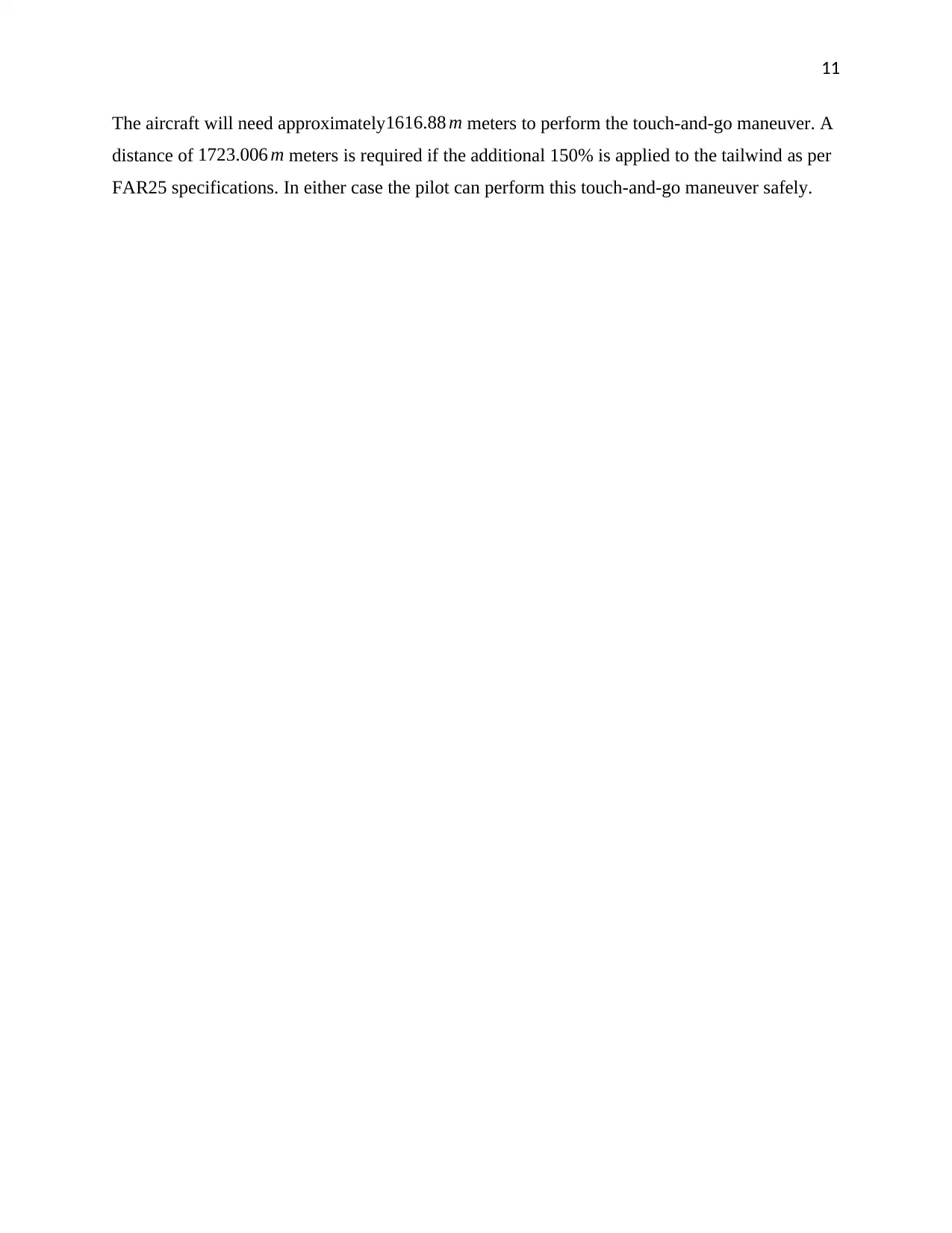
11
The aircraft will need approximately1616.88 m meters to perform the touch-and-go maneuver. A
distance of 1723.006 m meters is required if the additional 150% is applied to the tailwind as per
FAR25 specifications. In either case the pilot can perform this touch-and-go maneuver safely.
The aircraft will need approximately1616.88 m meters to perform the touch-and-go maneuver. A
distance of 1723.006 m meters is required if the additional 150% is applied to the tailwind as per
FAR25 specifications. In either case the pilot can perform this touch-and-go maneuver safely.
1 out of 11
Your All-in-One AI-Powered Toolkit for Academic Success.
+13062052269
info@desklib.com
Available 24*7 on WhatsApp / Email
![[object Object]](/_next/static/media/star-bottom.7253800d.svg)
Unlock your academic potential
Copyright © 2020–2025 A2Z Services. All Rights Reserved. Developed and managed by ZUCOL.